Plants are like people — some you like instantly, others you have to get to know and some will always remain charming acquaintances at the peripheral of your mind.
Mallows were in that middle category for me. They didn’t resonate with me until Christina Mild, one of our Thursday morning volunteer team mates, mentioned that mallow would be one of the few plants blooming in a drought, going to seed and feeding birds.
That caught my attention. That gave mallows validity, to know their usefulness to wildlife.
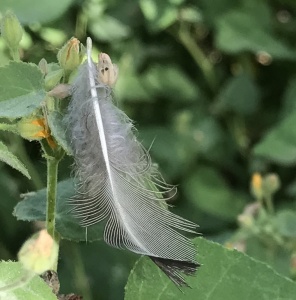
A little back story: We were looking at one of our newly rejuvenated Ebony Loop gardens in Harlingen’s Hugh Ramsey Nature Park, Hachinal Corner, which had been designed as a bird friendly garden a dozen years ago.
The bird-feeding trees and shrubs were hugely overgrown earlier this year when our Ebony Loop volunteer team spent a morning clearing native-but-aggressive dicliptera, trimming back out-of-control granjeno, and building a brush pile from Hurricane-Dolly-downed branches and other debris.
We freed up brush holly, Barbados cherry, caesalpinia, Tamaulipan olive, anacua, and other trees and shrubs that provide food for birds.
Now, what was cleared just a couple of months ago was filled with a dense sea of mallow as tall as my head.
I’m thinking, “Wow, overwhelmed!” Do we now need to tackle the mallow? Dicliptera is easy to pull out because, for all its aggressive glory, it has a wee, tiny root system. That’s not the case with mallows. You can’t easily tug them out bare-handed.
Hachinal Corner’s three furrowed Indian mallow, Abutilon trisulcatum, (Richardson/King book, Plants of Deep South Texas, page 305), is considered a shrub and can grow to five feet or taller.
Because of the benefit to birds, Volker and I chose to keep a healthy stand of the trisulcatum in Hachinal Corner and thin it out so it wouldn’t overtake the bench and the hachinal plants, Heimia salicifolia, (page 299, PDST) around the garden’s sign.

Although we are not in an officially declared drought, the trisulcatum last week was looking a bit wilted when this photo was taken, and still was pushing out blooms.
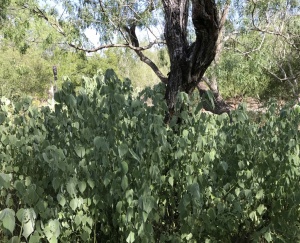
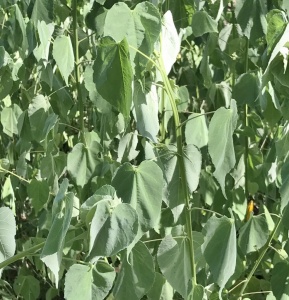
Then, Wednesday, a good, healthy rain fell over parts of the park and overnight the trisulcatum leaves perked up.
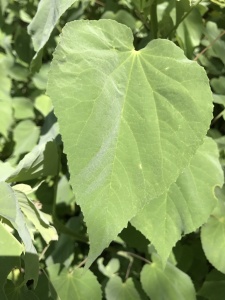
Trisulcatum is one of the plants Barbara Peet and I like to point out during our native plant tours. We explain that there are hundreds of mallows, but one that is very easy to identify is trisulcatum because the stem is distinctively three sided, and feels like a triangle shape.
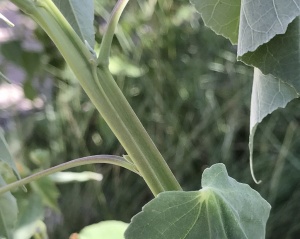
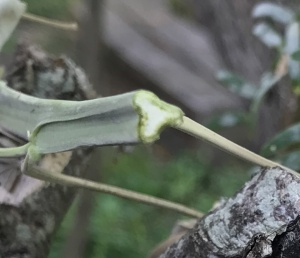
Mallow species are hard to distinguish. They are in the Malvaceae family — as are hibiscus, hollyhocks, okra, cotton and cacao — none of which are showcased in Ramsey.
That said, our native hibiscus, Tulipan Del Monte, Hibiscus martianus, PDST page 310, also called heart leaf hibiscus and Turk’s cap, Malvaviscus drummondii, PDST page 313, are both members of the Malvaceae family and are in various areas of the park. But those are stories for another day.
Most mallows have similarities:
· The leaves of many are heart shaped with toothed edges
· The leaves are hairy, soft and velvety to the touch
· The flowers generally have five petals
· Like many members of the malvaceae family, the flowers usually open in the afternoon and close during the morning, which is true with trisulcatum in this mid-morning shot.

· The plants contain natural gums called mucilage, pectin, and asparagin, which gives them a slimy texture when crushed
· Members of the mallow family are mostly edible as salad greens and potherbs, although not very commonly used, probably due to their slimy consistency. The flowers and seeds also are said to be edible. I was tempted to leave this bullet out as I am not an authority on “eating from the wild,” so do realize this is from Internet research and personal allergies may apply . . . .
· Mallow colonies have proved to prohibit the recurrence of Guinea grass after an area has been cleared. — not a stitch of Guinea grass is to be found in this section of Hachinal Corner!
Various Ebony Loop gardens sport two other species of mallow that are worthy of mention. Barbara and I like to point out a mallow when we get to Pigeon Berry Hill. We like to announce its name, Bastardia, because it generally gets a few laughs.
Mexican Bastardia, Bastardia viscosa (page 307, PDST) also is an easy mallow to identify in the field. If you rub the leaves, it has a foul odor. The name Bastardia, has nothing to do with classic British landed gentry whodunnits. It honors a distinguished French botanist, Toussaint Bastard.
Mexican Bastardia can grow to 40 inches tall. On Pigeon Berry Hill, it doesn’t seem to colonize as aggressively as trisulcatum.
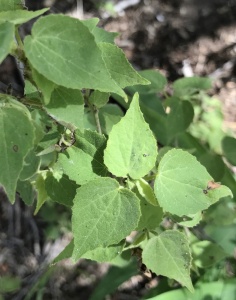
A third mallow, and this is pretty exciting, is mauve Indian mallow, Abutilon hulseanum, also called Jann’s Indian mallow.
Quoted from PDST, page 303: “This species was known only in Cameron County from old historic records. Recently a population in southern Willacy County was discovered by Jann Miller, a local native plant enthusiast.”
Christina Mild successfully propagated the plant from collected seed and shared a plant with our volunteer group. We planted it in The Laughing Garden on Ebony Loop at Ani Cut. This is my favorite mallow. The flowers are beautiful. Although it’s called mauve Indian mallow, the flower is a striking peach color. The shrub can grow to five feet or taller.

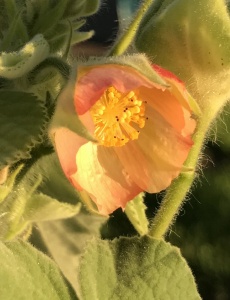
This mallow forms great seed pods that are as interesting as the flowers. The leaves, stems and even the seed pods are hairy.
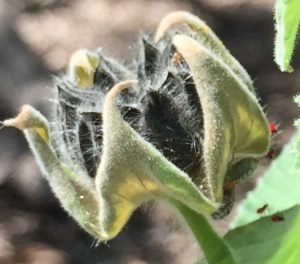
When the seeds are ripe, you can tip the pod over into a container and a dozen or so small, dark brown, round seeds spill out. We collected seed for Chris for future plants. We also scattered seeds around the mother plant in The Laughing Garden as well. Not successfully. The seeds were either eaten or didn’t germinate from lack of rain.
Bob-white quail eat the seeds of this mallow. (See Anita’s Blog, Home Grown Quail Food, second story under June 2015.) https://rgvctmn.org/2015/06/
We’ll continue attempting to establish Jann’s Indian mallow around the Loop.
I got some of Chris’ seeds for this mallow and also got no good results. I guess it’s just one of those hard to grow from seeds plants. Nice article!
Thank you, Frances. I am rather surprised that you had no success growing anything from seed. I consider you and Christina magical in that regard. Chris started some Jann Miller Indian Mallow for me and they are thriving. I’ll share some seeds with you. I will also share with you one of Christina’s secrets to germinating seeds — sow a bunch of them in the pot! Honestly, though, I also think it’s a hard one to get to germinate.